Plasterboard ceiling in a bathroom: pros and cons, design examples

When it comes to repairs, many people think about which materials are best to use, because it is important to consider the quality of the material, its durability and cost.
This article will focus on bathroom ceilings. Many people, most likely, did not even think about the fact that sometimes it is necessary to redo the ceiling in the bathroom.
Most often, this small room undergoes only light cosmetic repairs. But when the question arises about the complete transformation of the bathroom, the ceiling becomes the main problem of the entire renovation.
Drywall is a popular material on the market because it is lightweight, durable and pliable. It's easy to work with. This material is preferred by many consumers. It is used for the construction of walls, partitions and, of course, the ceiling.
But drywall has its own characteristics that should be taken into account during its subsequent operation.
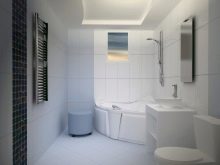
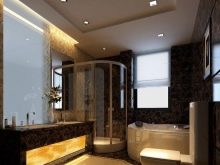
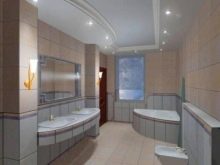
Design features
GKL is a cheap and affordable material that every buyer can afford. It is easy to work with it even for a beginner. Holes can be easily made in drywall, for example, for cable ducts, light bulbs or a cooker hood.
These beneficial properties appeal to consumers. But many buyers forget that there are two types of drywall. It happens:
- simple;
- waterproof.
Many people buy a simple plasterboard for the bathroom. This is the first mistake most people make when repairing. After some time, the gypsum board will become unusable due to high humidity.
A special impregnation makes drywall moisture resistant.The composition of this material includes a special antifungal and hydrophobic mixture. It is GKLV that should be used in the cladding of wet rooms and wet areas.
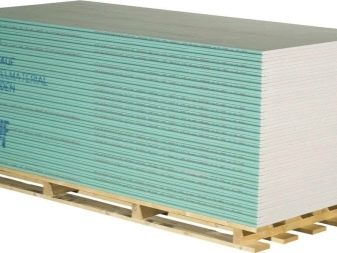
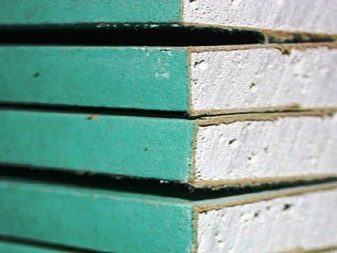
GKLV can maintain its original shape even when the humidity level in the room reaches 90%.
Before installing a plasterboard suspended ceiling in a bathroom, you should pay attention to the primer of the first, "native" layer of the ceiling. Even despite the presence of moisture-resistant drywall, evaporation will still occur. This means that fungus or mold may appear on an unprotected surface from strong moisture.
It is important to pay attention to ventilation in the room. The larger the bathroom, the more ventilation holes should be made.

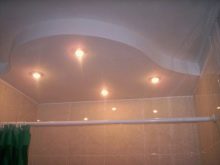
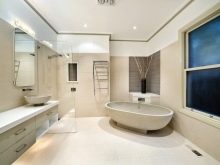
Advantages and disadvantages
Like any other material, drywall has both positive and negative sides. In order to avoid unforeseen situations, it is important to consider all the properties of the gypsum plasterboard.
- High level of moisture resistance, the presence of sound insulation and fire resistance of the plasterboard ceiling.
- Environmental component. Drywall is created from natural ingredients (gypsum, cardboard, starch) that are harmless to humans. The material is non-toxic and hypoallergenic.
- Nice finish. GKL helps to hide all the unevenness of the ceiling, bends, drops and cracks, as well as wiring and pipes.
- Fast and reliable installation. A person does not need a crew of workers to mount the ceiling. In the presence of the necessary tools for the work, installation is quite quick and easy.
- Price... As mentioned earlier, drywall is a very inexpensive material. But the price does not affect its quality in any way. The cost of gypsum board is due to the cheapness and availability of the materials that make up it.
- The ability to create any shape. Drywall can not only be cut and sawed out, but also gently bent, after moistening the fold.
- Possibility to putty all joints and irregularities... With the correct putty, the joints will not be visible.
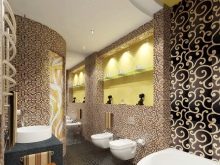


As for the negative aspects of using drywall, these shortcomings are often based on positive aspects, as if refuting them.
As mentioned above, drywall is a moisture-resistant material, so contact with water is tolerable. But still, this will not save you from a situation when the neighbors from above will suddenly inadvertently flood. GKL is a soft and pliable material, regardless of whether it is impregnated or not. For this reason, whatever the quality of the gypsum board, direct contact with a large amount of water is harmful to it and will render it unusable.
It should be noted that designers do not recommend making "extra awnings" in bathrooms with low ceilings, since the distance is reduced by 10-15 cm. This applies not only to the version with gypsum board, but also with a stretch ceiling.
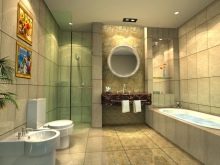
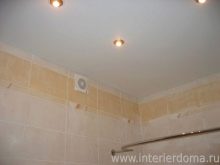
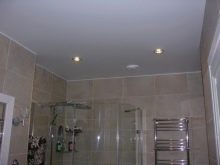
In addition to the drywall itself, you often have to buy many additional components for it. This significantly affects the cost of a false ceiling in the bathroom. For example, you should additionally purchase a metal frame, putty (better moisture-resistant), paint (in the bathroom you should use paint with the presence of silicone in the composition).
Hence, it can be argued that separately, a sheet of gypsum plasterboard is really cheaper than other materials. But at the finish line, it turns out about the same amount that a person would spend on a PVC ceiling.
If you do not provide an extractor hood in the ceiling or in the wall, the room will not be ventilated. The drywall ceiling is likely to deteriorate or delaminate. The bathroom will take a long time to dry out, since moisture remaining on the surface of the ceiling or absorbed by it will not evaporate.
The fumes will be absorbed by the gypsum board and destroy it, even if it has a moisture barrier. This is called the accumulation effect.

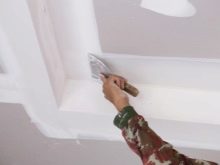
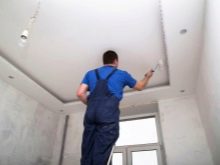
Design options
Drywall, as a material, is friendly with any style and interior.It will fit both the minimalism style and the loft and Provence.
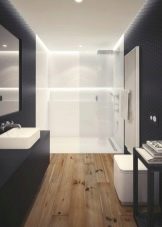
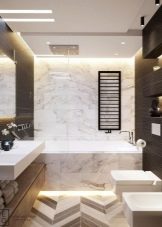
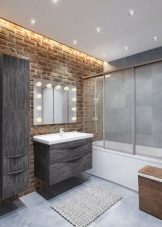
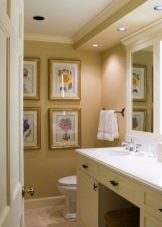
GKL is unpretentious, and it is a pleasure to work with it. You can create smooth curves or sharp geometric shapes.
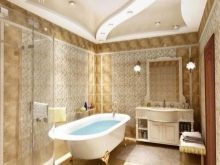
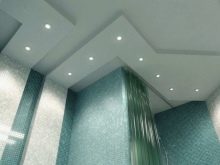
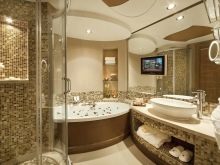
Plasterboard can be combined with any other material, such as mosaic tiles or wood, brickwork or cement.

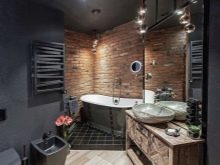
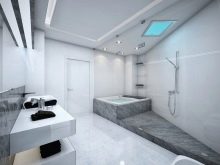
When creating a ceiling from gypsum plasterboard, the size of the room should also be taken into account. In a small space, large multi-level structures will look ridiculous and heavy. Even the abundance of light sources will not save the situation. In this case, you should make a standard ceiling without unnecessary protrusions. Point spots or diode tape around the perimeter of the ceiling will help to beat the smooth surface.
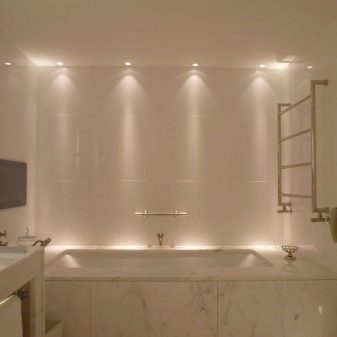

If the bathroom is small, and standard ceilings seem boring, then you can make two-level design. In this case, the protrusion can be made in the form of a wave or a circle. This option will help to visually highlight the area where the bath or shower is located.
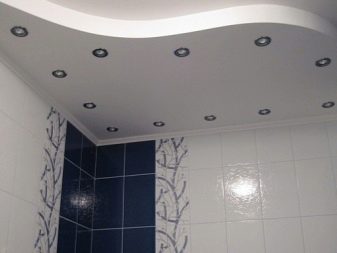
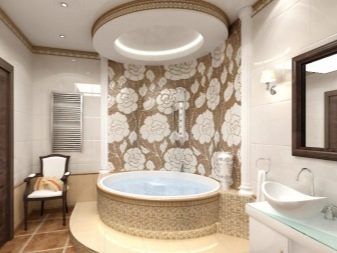
Successful examples in the interior
Creating a protruding niche on the ceiling will help to zone the space and visually highlight the location of the bath. The LED strip in the edging will not only outline the ledge, but also become an additional light source. To increase the light in the room, additional point spots should be installed in the niche.
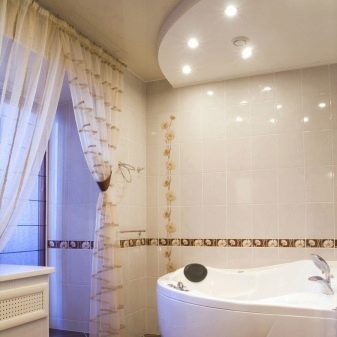
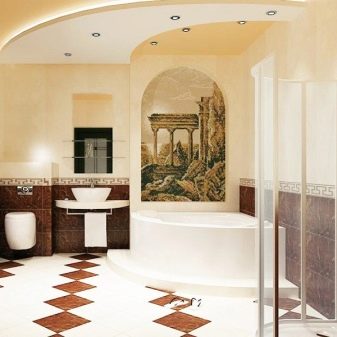
Many designers advise creating a false window in the ceiling. This simple technique will not only visually help expand the space, but will also become a "highlight" of the interior.
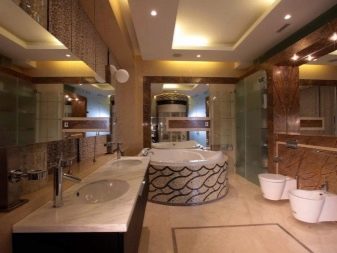
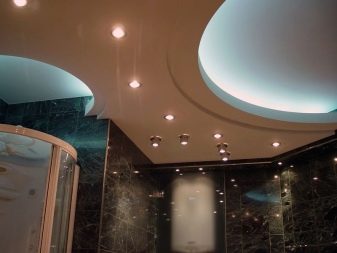
The light source is a diode tape and several small spots, which are covered with a matte plexiglass frame. This creates a cozy and relaxing atmosphere.
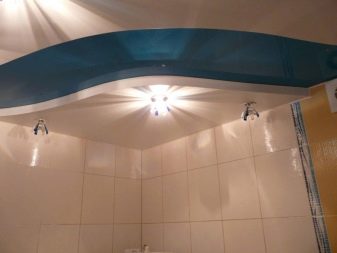
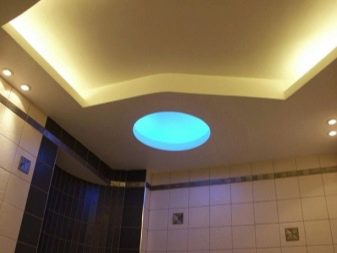
Next, watch a video with tips on how to mount a drywall ceiling with your own hands.






